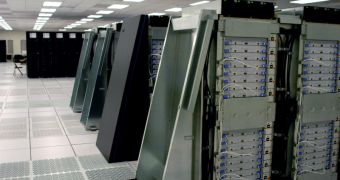The device will be developed and built by the Intel Corporation and the SGI, and will be installed at NASA Advanced Supercomputing facility at the Ames Research Center. It is expected to become operational by 2009, when it will have a computational power of one petaflops. Then, until 2012, the new supercomputer will receive upgrades that are supposed to bring it to a computational power of 10 petaflops. By comparison, NASA's fastest computer, Columbia, operates at only 88.88 teraflops.
One "FLOPS", or Floating Points Operation Per Second, represents the measure of a computer's power and is similar to the Operations Per Second measurement used to estimate the power of personal computers. The "Floating Point" term refers to the most common format of numbers used in scientific calculations. Basically, the term Flops defines the speed at which a computer performs simple arithmetic calculations - such as adding or dividing.
The 'peta' term stands for one quadrillion, while 'tera' means one trillion. To put it simply, a one petaflops supercomputer can perform 1,000 trillion basic calculations per second. NASA will use its new supercomputer to model and simulate various events such as the landing on celestial bodies other than the Earth, or to design hypersonic aircrafts and spacesuits.
According to the TOP 500 list of world's most powerful computers, the supreme title is currently held by the BlueGene/L system, developed by IBM and the US National Nuclear Security Administration, that operates at 478.2 teraflops per second.
"Achieving such a monumental increase in performance will help fulfill NASA's increasing need for additional computing capacity and will enable us to provide the computational performance and capacity needed for future missions," said Ames Research Center director Pete Worden. "This additional computer performance is necessary to help us achieve breakthrough scientific discoveries," he added.
"Intel, working with SGI, is proud to play an important role in helping NASA expand the pursuit of scientific discovery. Systems such as Pleiades challenge the imagination, and guide our exploration of Earth, space, and beyond. As we approach performance that was once thought impossible to achieve, our eyes are opened even wider to the vast possibilities enable by supercomputing," says Diane M. Bryant, vice president of Intel's Digital Enterprise Group.

 14 DAY TRIAL //
14 DAY TRIAL //